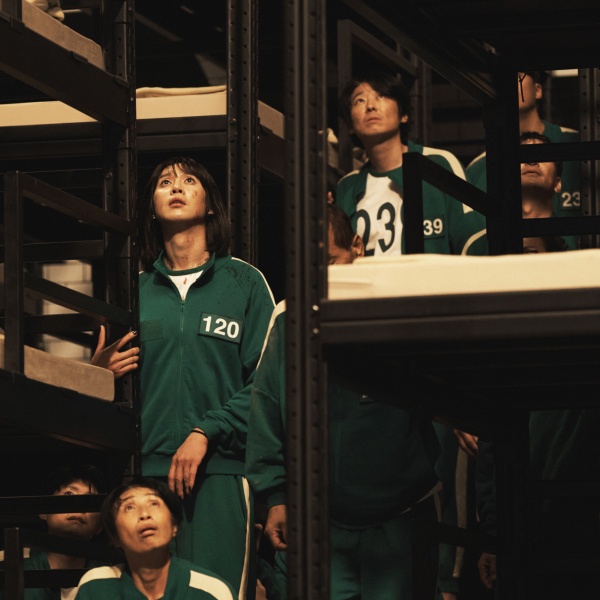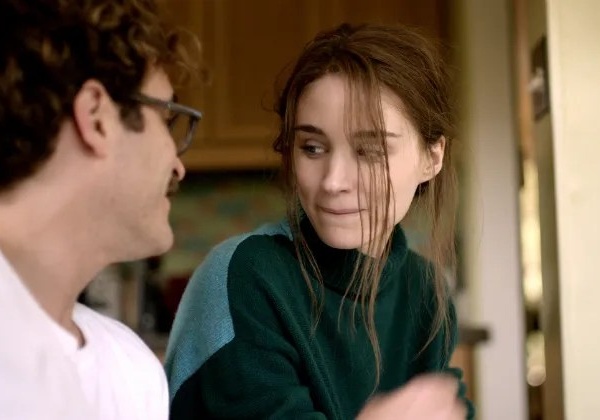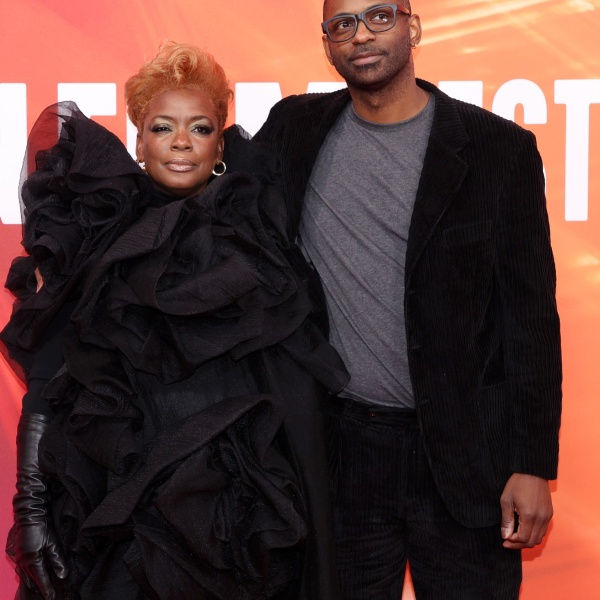Filmmaker Says Ballet Horror Was 10 Years In The Making; Is Glad His Old Boxing Project ‘The Fighter’ Is In Good Hands

It’s more than appropriate that when we sat down to chat with Darren Aronofsky, director of this week’s flat-out brilliant ballet world thriller “Black Swan,” we would do so under a giant framed photograph of Peter Cushing, Christopher Lee, Vincent Price, and John Carradine. The icons of horror seemed to be giving Aronofsky their blessing, and on the eve of his own super-spooky movie, seemed to be saying: “Welcome to the club.” He’s in good company. And “Black Swan” is a very worthy inclusion in the canon of horror greats.
Could you talk about the gestation of the project? And was Natalie Portman always attached?
I met with Natalie 10 years ago. She was still in college. We met in Times Square, at the Howard Johnson’s, and had a cup of joe there, which I think is probably an American Apparel. But I always thought she was right for it. And over the years she said, “How’s the ballet project coming? I’m getting too old to play a dancer!” And I was like, “Don’t worry, it’s coming along.” It just took a really long time to understand the ballet world and understand “Swan Lake” and figure out a way to communicate that world to an audience that in general doesn’t understand ballet (like myself), so I really had to learn a lot about it. Natalie is a really interesting actress because she’s very talented and very beautiful and very youthful and she’s cast very young, a lot. And as I got to know her I realized she’s also a woman, so I loved the idea of taking this girl as everyone perceives and pushing her away from her innocence.
You’ve said that this was originally part of the idea that became “The Wrestler…”
That’s not true, actually. That was an early interview and it got confused. There was a love interest in this ballet project, when it was just in theory, but it had nothing to do with wrestling. It got confused. And now I’m still answering that.

At what point did you decide that it wouldn’t be a straight drama like “The Wrestler“ and that you’d push it into these more supernatural realms?
Well, I think it always had this kind of terror edge to it, which I was very intrigued about. It was a big challenge to do those cheap scares, because the bottom line is: they are cheap scares. There’s no way getting around it. You’re basically hiding behind a wall and going “Boo!” to the audience. But it’s fun. I do it to my 4-year-old everyday, we scare the beejesus out of each other and giggle and laugh. And I’ve always liked that in movies. My mentor was Stuart Rosenberg, the guy who directed “Cool Hand Luke” and a bunch of other films, and he said: “You’ve either got to make them laugh, cry, or scare the shit out of them.” So I kind of liked the exercise of trying to do these scary elements. So that was always there. But the big breakthrough was when we threw everything away, after 8 years of developing this kind of more typical thriller and realized that this film was going to be about “Swan Lake,” the ballet, the actual fairy tale. Because it was all there for us: there was this doppelganger, there was a black swan and a white swan, there was this werewolf story of this metamorphosis, the story of a woman who is by day a swan but at night is a half-swan/half-human — that always got me excited because I got to turn Natalie Portman into some weird creature. And all of the characters in the movie are sort of related to their counterparts in the ballet.
You stepped back and completely reapproached it.
The best way to understand what we did kind of is what Clint Mansell did with the music: he took Tchaikovsky’s masterpiece and ripped it apart and deconstructed it and found certain themes that he liked and then added his own thematics to it and then re-recorded it with an 80-piece orchestra and made it its own piece. The ballet is 2 and 1/2 hours and we compressed it to our 100-minute long film, but it’s still in order of the actual ballet. We cut out pieces, but every piece is in the right place, to a certain extent. Which is cool. Because that was part of the exercise: making the ballet into a movie.
There’s a thematic connection between sexuality and creative expression, which is also connected with the pursuit of perfection. What’s the correlation to you?
That’s a big conversation. And I’m not sure if there’s correlation or if they’re just parallel paths. But, you know, ultimately there’s a story here of a woman-child, a child trapped in a woman’s body trying to become a woman, and her sexual liberation is a big part of becoming a woman. And also her ability to be a true creative contributor is probably connected to that too. It’s kind of a coming-of-age story underneath this, to a certain extent, and we were aware of that. We always talked about those types of ideas, me and the writers.
Getting back to the score: in addition to Mansell’s music there are also a few new Chemical Brothers songs that incorporate elements of the ballet.
That was always the idea. There’s a section of the film where we leave the ballet world and go into a very contemporary setting that would have dance music. So it was a big question of how we were going to do that, because we didn’t want to leave this kind of boundary we had created of using Tchaikovsky’s music to inspire us. So what we did was went to the best electronic musicians in the world, and got a group of six or seven of them, and then we assigned them each different key themes of Tchaikovsky and said, “Take this and turn it into a dance track.” And they all approached it in different ways. Some of them let the Tchaikovsky melody turn into chord progression or turn into beats. They all had a different ways of addressing it. And Chemical Brothers, who did two or three of the tracks, if you listen to the tracks you hear Tchaikovsky. So it is Tchaikovsky wall-to-wall either through these electronic musicians or through the mind of Clint Mansell.
You were also attached to do “The Fighter” for a long time, which is now coming out and you’re an executive producer on that one. Is there any feeling of competition there as the two films enter the Oscar race?
No! They’re very, very different movies. I spent a lot of time developing that film with Mark Wahlberg and Scott Silver, who is the main writer on it with me, and I really pushed him to do it. And then I made “The Wrestler.” And it was a little tricky to go and do another film that was in a similar ballpark, even though they’re very different movies. And I bowed out. So I was thrilled with someone like David O. Russell showed up to do it.
It’s in good hands.
Yeah, I remember at film school, it was really competitive and it was competitive in an ugly way. Although Scott Silver and Matthew Libatique, my DP, and Matthew Watson, my producing collaborator, those are guys I met in film school and they became collaborators for life. But when I got to Sundance with “Pi,” I became good friends with all of these other filmmakers. Like I was with Lisa Cholodenko the other day, who was there with “High Art.” And it wasn’t really competitive, people were really supportive. And what I realized what if you gave the same script to me, Wes Anderson, Todd Solondz and we all went do do a different film from that script, it would be its own thing. David is one of those guys who I look up to, “Spanking the Monkey” was a huge inspiration when I was a student filmmaker, so I was so thrilled that they got someone who was a filmmaker and not a hack. They got a real guy. So I was dying to see it and when I saw it, I thought it was an amazing thing.
So the competition in the film isn’t there in real life?
I mean, they’re not going to be competing. Luckily, they don’t have a lead female. If they did I’d be really upset because I want Natalie Portman to get all the recognition she deserves. I mean, she worked her ass off — a year of training, 8 hours a day, transformed her body, and became the character. And it was really challenging, with no money. And I’m very proud of her. And all of my collaborators. But I don’t think we’re head-to-head on much.
Can you talk about the success of “Black Swan” and how it’s influenced your new development deal at Fox?
I don’t know if it’s influenced it much. I mean, I know Tom Rothman liked the music a lot, which was great, because I think he has a good eye. I’ve had an overhead deal for years now but like being at a place like Fox because they have big Fox, which makes great, big movies. And they also have Fox Searchlight, which is one of the only games in town for independent films. And I have a lot of aspirations on both sides.
You have “The Wolverine” coming up, which you’ve said is going to be a stand-alone movie, but is there anything you can say about the villain?
[Nervously] To be honest, I really haven’t put my brain into it yet.
You’d better start, the clock’s ticking!
You’re right, the clock is ticking… But I think it’s going to be really unique. Once I get done with it, I imagine it’ll be really unique. But I don’t know. Because I really haven’t started creatively attack it. And if I think about it I just get stressed out, because there’s so much to do.
Is there anyone you’re looking to work with, actors-wise?
I haven’t even started yet. I know I’m probably going to be working with some guy named Hugh Jackman. I hear he’s lovely.
He was in some movie called “The Fountain.”
Exactly. [laughs]
“Black Swan” hits theaters in limited release this Friday, December 3. You can read our review of the film from the Toronto International Film Festival here.






